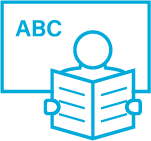Reading and Writing Ability in Relation to Home Environment: A Study in Primary Education in Rural Tanzania

This study examines how the home environment related to the reading and writing ability of 300 Kiswahili-speaking children in grade 3 living in a rural area in eastern Tanzania. Results showed that reading and writing skills correlated moderately or highly with home environment variables, especially, fathers’ education, house wall material, number of books for school subjects, and parental involvement in the child’s school learning.
Author: Damaris Ngorosho
Source: Ngorosho, D. (2011). Reading and writing ability in relation to home environment: A study in primary education in rural Tanzania. Child Indicators Research, 4, 369–388. DOI: 10.1007/s12187-010-9089-8
This study examines how the home environment relates to the reading and writing ability of 300 Kiswahili-speaking children in grade 3 living in a rural area in eastern Tanzania. Three hundred grade 3 children were assessed for letter, word, and sentence reading and word-writing abilities. Mothers responded to a questionnaire-based interview about the home environment. Results showed that reading and writing skills correlated moderately or highly with home environment variables, especially, fathers’ education, house wall material, number of books for school subjects, and parental involvement in the child’s school learning, all of which predicted reading and writing ability.
- The home environment is known to play an important role in the development of reading and writing ability.
- The home environment is a social context in which children live with people who contribute to their development in reading and writing ability.
- Home environment, family, the neighbourhood, peers, and other settings such as school, are the immediate contexts or settings for children’s learning.
- Bronfenbrenner (1977) emphasised that a person’s development occurs through processes of shared interactions and activities that occur within microsystems.
- Parents with a higher level of education talk to and use more complex and varied language with their children, which in turn predicts better reading skills.
- In addition to educational materials, interactions between parents and children while they engage in literacy-related activities are likely to be relevant for the development of reading and writing skills.

The study
This study examined the relationship between home environment and reading and writing ability among Kiswahili-speaking children from a rural, low-income area in Tanzania.
Participants were 300 randomly sampled grade 3 children aged between 9 and 12 years. Children were assessed on letter, word, and sentence reading and word-writing abilities. Mothers responded to a questionnaire-based interview about the home environment.

Findings
- More than half of parents had attained education at primary level or lower.
- More than half of participants’ houses were constructed from low quality materials for the walls, roof, and floor, whilst more than 60% of the families accessed water from a public tap.
- Approximately 57% of the families had one or no books to support their child’s learning in the home, and 33% of parents were not involved in their child’s school learning.
- Children performed at a level between 50% and 70% of the maximum scores on reading and writing tests.
- Home environment factors explained 31% of the variance in reading and writing ability.
- Fathers’ education, the quality of house wall material, availability of books for school subjects in the home, and parental involvement in the child’s school learning were identified as strong predictors of reading and writing ability.
- Parental involvement was a predictor of writing ability.

Practical Implications
- The significant variables predicting reading and writing ability were fathers’ education and those describing housing and the home literacy environment.
- Home environment variables accounted for almost one third (31%) of the total variance in children’s ability to read and write.
- Due to overcrowded classes (up to 100 children in primary schools in some areas), teachers use a chanting-like chorusing method to teach reading and writing.
- Study results indicate that in addition to approaches based on improving the curriculum and school environment, the focus should also be on actions for improving the home environment and parental involvement in their child’s school learning.